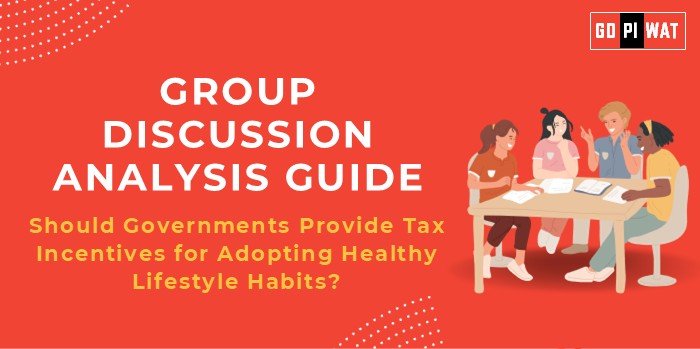📋 Group Discussion Analysis Guide
🌟 Topic: Should Governments Provide Tax Incentives for Adopting Healthy Lifestyle Habits?
🌐 Introduction to the Topic
Context Setting: “With lifestyle diseases such as diabetes, obesity, and heart conditions on the rise globally, governments are exploring policy interventions, including tax incentives, to encourage healthier lifestyles. This approach ties directly to reducing healthcare costs and enhancing public well-being.”
Background: Tax incentives for health-promoting activities, such as gym memberships, healthy food purchases, or preventive care, have been trialed in various countries, with mixed results. Recent debates highlight their potential to reduce the economic burden of healthcare while raising questions about implementation fairness and effectiveness.
📊 Quick Facts and Key Statistics
- Global Obesity Rate: 13% of adults are obese (WHO, 2023).
- Economic Impact of Unhealthy Lifestyles: $2 trillion annually in healthcare costs worldwide (OECD, 2023).
- Preventive Care ROI: Every $1 invested in preventive care yields $6 in savings (CDC, 2023).
- Healthy Food Cost Differential: 20% higher than processed food on average—highlighting economic barriers (FAO, 2023).
🤝 Stakeholders and Their Roles
- Governments: Formulate and implement tax policies to encourage healthy behavior.
- Healthcare Providers: Promote awareness of tax benefits and monitor health outcomes.
- Citizens: Adopt healthier habits influenced by financial incentives.
- Private Sector: Develop health-focused products/services aligning with tax policies.
🏆 Achievements and Challenges
Achievements:
- Improved Public Health: Singapore’s tax incentives have led to a 15% reduction in obesity rates.
- Lower Healthcare Costs: Sweden saved $500M in healthcare through fitness subsidies.
- Economic Boost: Increased demand for health-related services/products.
Challenges:
- Accessibility Issues: Low-income groups may not benefit equally from tax incentives.
- Policy Misuse: Potential for fraudulent claims.
- Global Comparison: While Singapore succeeded, the U.S. saw limited results due to administrative complexities.
- Case Study: Japan’s “Metabo Law” incentivized companies to reduce employees’ waistlines—successful but controversial.
🗂️ Structured Arguments for Discussion
- Supporting Stance: “Tax incentives for healthy lifestyles reduce healthcare costs and boost productivity, ensuring a healthier workforce.”
- Opposing Stance: “These incentives may disproportionately favor higher-income groups while failing to address the root causes of unhealthy habits.”
- Balanced Perspective: “While tax incentives can motivate healthy behaviors, they must be complemented by widespread awareness and accessible infrastructure.”
🎯 Effective Discussion Approaches
- Opening Approaches:
- Highlight economic data showing healthcare cost reduction via preventive measures.
- Use contrasting examples (e.g., Singapore vs. U.S.) to underscore implementation challenges.
- Start with a question: “Can tax policies truly influence long-term health behaviors?”
- Counter-Argument Handling: Address equity concerns by suggesting tailored policies for different income groups.
📊 Strategic Analysis of Strengths and Weaknesses
- Strengths: Potential for public health improvement, cost savings, increased health sector innovation.
- Weaknesses: Implementation complexity, equity concerns, resistance from processed food industries.
- Opportunities: Technological integration (e.g., tracking apps for tax rebates), global partnerships.
- Threats: Misuse of benefits, lack of measurable health outcomes.
🌍 Connecting with B-School Applications
- Real-World Applications: Policy analysis projects, public health initiatives, and operations in healthcare startups.
- Sample Interview Questions:
- “Evaluate the role of tax incentives in promoting sustainable healthcare systems.”
- “How can businesses align with government health policies to maximize impact?”
- Insights for Students: Explore how fiscal policies can drive societal change, blending economics with behavioral science.


